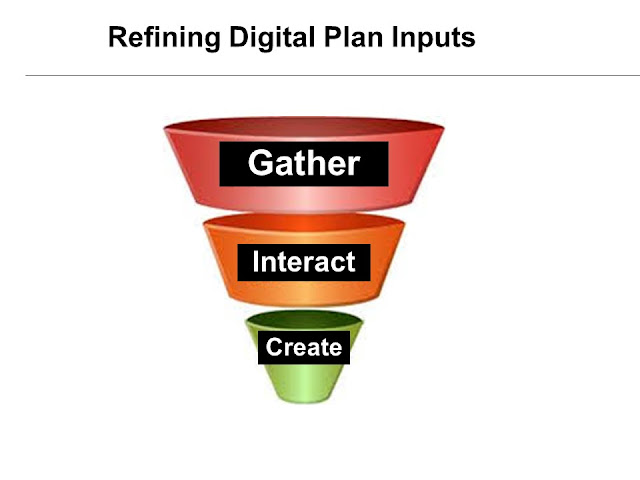The quality and attainability of an organizations digital plan depends not only on the target plan and the process to get that digital plan, but the inputs that are guiding the decision making process during the distillation of the digital plan. This post will identify and describe the top inputs necessary for a digital plan that can act as a base that will be modified as experimentation, experience and business conditions indicate a potential change. Please see the following post for the content of a digital plan:
http://jimsinur.blogspot.com/2015/11/the-top-seven-ingredients-in-digital.html
Executive Vision:
In order craft a digital business plan, you need to know where the executives want to take the organization. There are strong threads in the original organizational charters and motto, but digital will likely infuse some important add on statements. Listening to corporate financial result meetings and getting access to executive statements, face to face or second hand, will give guidance and constraints for a digital plan.
Operational Plans:
Operational plans gives executive vision legs to make the year to year journey. Scouring operational plans will give strong direction to the digital plan. It will also show role and goal conflicts that will have to be dealt with in creating and implementing the digital plan. The more granular the plans, the more likely you will find and deal with goal conflicts during the interaction phase of creating a digital plan.
Customer Input:
Traditional customer input usually revolve around surveys and focus groups. While these are helpful, they are generally biased towards desired responses. This is where creating true customer journey mapping and experimenting with customer interfaces and interaction models really help create a desirable digital plan.
Competitive Trends:
While doing a formal competitive bench mark is always an option, there are other potential inputs to the digital planning process. If an organization has a competitive organizational unit that tracks the competition, that unit has a multitude of sources of information on the competition (traditional or non-traditional). If there is no official part of your organization watching the competition, then things like industry forums and organizations are good sources as well as digging on the Internet.
Existing Constraints:
There may be historical events in any organization that may inhibit the progress of a digital plan and they should be identified early. Along with executive bias, deep political waters and emerging governance issues, there may be constraints that will shape the delivered plan. Here is another opportunity to identify sticking points for the plan as it rolls out during execution.
Digital Technologies:
Having a list of candidate digital technologies, their definition, strengths, weaknesses, success and failure stories is an essential ingredient in baking a digital plan. It would also be helpful to identify the relative maturity of each of these technologies and the likely hood of each of success within your organizations culture. As usual the cost benefits need to be identified along with proof of concept projects with potential experiments.
State of Legacy:
Your legacy is likely to drag you back when implementing a digital plan, so having an analysis of your legacy portfolio is a handy input. You will likely decide which legacy assets will be carried forward in a modified basis or just left to decay. A good plan will identity those assets that should be cut out phased sunset like fashion.
Net; Net:
The old saying is "garbage in equals garbage out", so selecting and gathering the right inputs to for your digital planning efforts is a key step in creating an effective digital plan that will morph and change over time with experience and feedback.
Additional Reading on Digital:
http://jimsinur.blogspot.com/2015/10/what-is-digital-business.html
http://jimsinur.blogspot.com/2015/11/is-digital-for-everything.html
http://jimsinur.blogspot.com/2015/11/getting-to-situational-business.html
http://jimsinur.blogspot.com/2015/10/selecting-technology-partners-for-your.html
http://jimsinur.blogspot.com/2015/10/creating-digital-business-platform.html

This comment has been removed by a blog administrator.
ReplyDelete